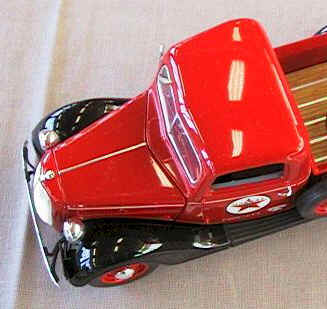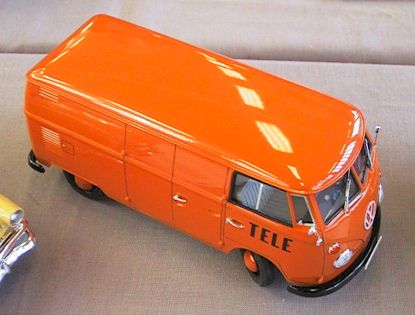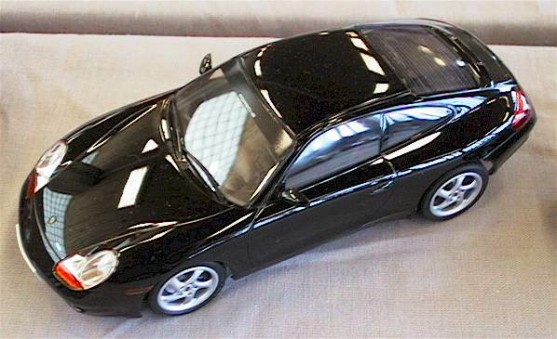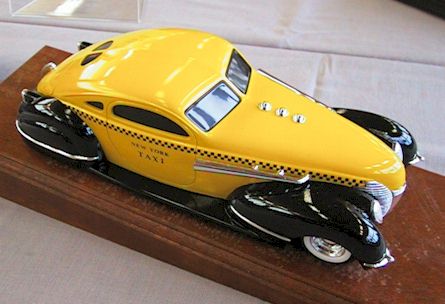by Rio de Janeiro Model Car Club, via Alaor Gosdal
English translation by Marty Oberman, Jr.
This material has been first published in portuguese at the home page of IPMS Curitiba, Brasil. Re-posted here in English version by kind permission of the copyright owner (Ed.)
This text is not a complete course on model car painting. The object is to pass on to car modellers the procedures on how to airbrush with automotive paints. The guidelines apply primarily to scale car models, but should be equally applicable elsewhere.
Why use automotive paint?
These paints show lots of advantages over the ones made specifically for modelling. One of the most important is their ability to produce very thin coats, which can leave all body details crisp even after many applications. Aside from their excellent coverage and thickness, they dry to the touch almost immediately and can be polished after 24 hours. This fast drying time decreases to almost zero the chances of dust adhesion to the painted surface.
The colour palette is almost unlimited. Car manufacturers add new colours every year and also old colours are always available through the new mixing machines.
The thinner issue
How to apply automotive paint over styrene plastic if its thinner contains toluene? Toluene is one of the components of plastic glue because it melts the plastic. In this application special care should be taken. There are kinds of model plastic that are mostly unaffected by these solvents (AMT, Revell, Tamiya and Monogram). Others like Gunze Sangyo react badly.
In our surveys we found a thinner that is least likely to affect plastic. The trick here is to find a thinner that has less toluene in its formula — the less toluene, the less harm to plastic. There are also many grades of thinners, faster and slower ones, in relation to drying time. The faster the drying time, the less chance that it will affect the plastic. The slower the drying time, the more chance of plastic attack.
Since thinner brands will vary from country to country, you will need some tests and visits to a good automotive paint store. Ask as many questions as possible of a local technician with the above information to find out which brand will do the best for you. It’s better to pay more for a higher quality thinner (with less toluene) that will be better for your plastic models. Remember also that you will have thinners for thinning base paints and others for better final result, more on this later.
You can start with a thinning of one part of paint to 2-3 parts of thinner. This is a starting point, experience will show what’s better for you. Don’t worry about coverage due to this thinning rate– with more coats it will cover the plastic in the desired colour and, even after many coats, all surface detail will still be visible. Important: Thorough surface preparation is a must! Due to the very thin paint film, no surface scratches will be hidden by paint.
Tip
You will do better with high grade thinners containing less toluene and better materials– they are more expensive but usually less harmful to styrene. Always run a test on a tree from the model you will paint.
Applying the base paint
Automotive paints can be divided in two families: nitrocellulose-based and acrylic. Note that due to environmental restrictions, nitrocellulose paints may not be available anymore in most countries.
Our experience with automotive paints shows that nitrocellulose based ones do not have a good adhesion to styrene. What do you do if you want to use this kind of paint? Easy. Always start with a base coat of automotive acrylic and then apply this paint on top.
Automotive acrylics adhere very well to plastic. To be sure that the paint is dry – it will be dry to the touch in seconds, but what about the paint under the surface? – smell the model. If you still can smell the paint it needs more drying time. When you can’t smell the paint anymore, it means the paint is dry and the thinner has evaporated.
Small particles and dust that get stuck on the surface can be eliminated (after paint is completely dry!) by sanding with a wet used 600 grit sandpaper. After this, leave your model to dry and you can continue your work.
The base paint does not only help with paint adhesion. If you have a red plastic body and you paint it with red it becomes very difficult to tell if you have painted enough coats. So the best way is to use an acrylic paint as a base in a contrasting colour. White and silver are the best here with some advantages. White is better if final colour is light or transparent – automotive reds, pearls and some blues are in this category.
Silver has another important advantage. The metallic parts in the paint (aluminium is used in different grades to add the metallic look to paints) will help protect plastic on the first paint coat, forming a kind of barrier between plastic and the paint. Also, silver covers better than white, which means less coats.
After the base is completely dry, you can start applying other coats without any problem, just like you perhaps used to do with your traditional model paints.
Tip
A thin coat of Tamiya acrylic paint, left to dry overnight, can act as a protective barrier against automotive solvents.
Paint application
This part must be read very carefully and as with anything in modelling, the procedures should be tested until mastered. Don’t worry if on the first try it doesn’t turn out as expected. This paint can be removed without damaging the plastic as we will see later.
Before you start painting, all parts must be washed with water and detergent, the same type as used for dishes. This removes all traces of molding agents used in the plastic injection process. Do not use anything to dry the parts — leave them to dry naturally with air contact.
The automotive paints must be applied with an airbrush. Do not use a brush because it dries so fast that the brush will be hard and unusable after only a few seconds. When spraying with an airbrush, it’s better to use a compressor that has a pressure regulator and a moisture and oil filter. The pressure to be used in the airbrush must be enough to spray all paint. Paint should come out as a spray– not like rain. Something between 20-25 PSI of pressure will be enough for good results. More on pressure later.
The first coat or base paint should be applied very carefully because as explained before some plastics are more affected by thinners. These first coats should be applied like a ”dust of paint”, i.e., more air than paint. This way the paint will arrive at the plastic almost dry, giving the thinner less chance to damage the plastic. This technique should be used on all plastics but especially on the more affected ones (Gunze!). The driest spray is obtained with more air pressure (start with something like 25-30 PSI). Also airbrush tuning to use more air than paint is a must here, too.
Start spraying your model without any hurry. Never stop the spraying pattern over the plastic. This can lead to plastic ”crazing”. A uniform, solid-coloured and even surface means that plastic is covered and your parts are protected for the next coats.
At this point all surface defects that passed before can be corrected with your favourite putty used before this base coat. After this base coating it’s good to wet-sand carefully the body with a used 600 grit or a new 1200 grit sandpaper, to even out the surface.
For the consecutive colour coats you should lower  the pressure to something between 20-25 PSI. With less pressure and more paint/air proportion coming from the airbrush these coats will be more ”wet” than previous ones, i.e., more paint – less air. Start with the corners and bumps just to deposit more paint in these places. The idea here is to avoid the polishing process to remove all paint from these places and reach the plastic.
the pressure to something between 20-25 PSI. With less pressure and more paint/air proportion coming from the airbrush these coats will be more ”wet” than previous ones, i.e., more paint – less air. Start with the corners and bumps just to deposit more paint in these places. The idea here is to avoid the polishing process to remove all paint from these places and reach the plastic.
For the final coats, lower the air pressure to 14-18 PSI and apply a wet coat, but without letting the paint drip. This will lead to a very smooth surface that will be very easy to polish. If your painted surface comes out with ”orange peel”, stop immediately: something is wrong. Smoothing out this surface with polish will be way more difficult. If necessary, remove the paint. Probably you need to add more thinner to the paint or lower the air pressure.
Tip
Look for fine sandpaper at automotive paint stores– good ones carry very fine 1200 and 2000 grit types.
Final colours
These paints can be metallic, pearl or solid. The metallic colours have small aluminium particles that add the metallic look to the paint. The pearl ones have small particles of a mineral called mica that is responsible for the more subtle pearl look.
The effect of the pearl is different from the metallic. During the painting process the paint jar must be shaken frequently because the pearl particles go to the bottom of the jar very fast. Only pigments make the colour.
Both nitro and acrylic solid colour paints can receive a clear coat to obtain a deep shine like a mirror. This depends largely on your taste, but the metallics and pearls need a clear coat. That’s why they are called double-coat paints by some paint manufacturers. Do not paint with metallic or pearls without a final clear coat. We will return to this later.
Problem correction
If, after you have finished your paint job, your painted surface has problems, sand them with a used 600 grit sandpaper — used wet — or better, with 1200 grit ones. The sanded spot will get flat, but don’t worry, the polishing process will get the shine back and will take the sanding marks out.
If your paint job leads to a result you don’t like and you want to remove the paint to start over, just get a recipient that has a cover filled with ethanol alcohol (that you get at drugstores). Put the parts inside for 2-3 days. Afterwards, brush them with a used toothbrush. All the paint will come out without any damage to the parts themselves.
Another way to remove automotive paints that’s faster but more expensive is to use automotive brake fluid instead of alcohol. It works in about 8 hours. Use the lowest grade of brake fluid, it works better than the good grade.
Polishing
Even the perfectly applied automotive paint needs polishing. This is a very important step — it is your final job. There are two polishing methods at your disposal:
Method 1. Use of materials found in automotive paint stores.  24 hours after the last coat, you can use a polishing cream like T-cut. Its function is to even out the surface. It must get even and smooth — at this point shine is secondary. After this, your model should be washed with water and soap and a used soft toothbrush, especially on the lower surfaces, in order to take out all residues.
24 hours after the last coat, you can use a polishing cream like T-cut. Its function is to even out the surface. It must get even and smooth — at this point shine is secondary. After this, your model should be washed with water and soap and a used soft toothbrush, especially on the lower surfaces, in order to take out all residues.
Now, it’s time for the thin polishers like Kaol or carnauba wax. They remove the ”fogging” left by the strong polisher. The model should be washed again as before.
Next you can use one of those polishing liquids like 3M High Shine or Meguiar’s (needs some survey at a good auto store for its name in your country). The 3M liquid has a light brown colour and contains no silicone. Apply it to the surface with a piece of cotton and let dry. Then with a new piece of cotton, polish the surface. Cotton is almost non-abrasive. After that you can use the Tamiya Modeling Wax to protect your paint job from fingerprints.
Method 2. Use of a model polishing kit. Here the technique is different, but with excellent results too. You can use those polishing kits like Millenium 2000 or Micromesh. They are made up of polishing cloths of different grades like: 1800, 2400, 3600, 4000, 6000, 8000 and 12000 grit. The process here is to use the coarser ones to even out the surface and then the finer ones — without skipping any — to remove the scratches from the previous one. After this you can use the carnauba wax and 3M as before.
Clear coat
The clear coat gives a deep colour impression. This coat must be generous. A thin coat can be removed in the polishing process and if colour shows up it can be slightly different in shine at this spot.
Application of the clear coat over solid colours is optional, but is a must in metallics or pearls. In older car models where you want to duplicate the original paint job, clear coats should be avoided.
Clear coat over decals
Here a test is always necessary, because different decals react differently. Always run a test first. Every decal sheet has a decal that will not be used, use it to perform a test with you paint. Basic experience with decals and the following tricks will help you to clear-coat your decals.
The test procedure and the clear coating process is the following: apply the decals as usual after the last coat of paint. Leave the body with decals drying at least for a week. This way all humidity will dry up. This is very useful in humid places and when decal setting solutions are used.
After this period of time airbrush the decal with clear paint in a light mist coat of automotive acrylic clear. Apply more air than clear. Let dry for 24 hours. Repeat this process two more times in 24-hour intervals. Now apply two more wet coats in 12-hour intervals. Now apply final two ”wet” coats.
From this point on you can apply those wet coats for that bright shine wanted, decals are sealed and protected from thinner and clear coat.
Tip
Always use automotive acrylic clear – check your local car paint store for one that doesn’t yellow with time. Never use nitro based ones, they yellow with time very distinctely, spoiling the paintwork of your model.
A few final words
Learning how to use automotive paint to its best advantage may take some experimenting. Don’t worry if on the first try it doesn’t turn out as expected. If you used to work with model paints, your initial results will probably improve over time as you adjust to the different characteristics of the new medium (viscosity, drying time, etc). In time you will find the ideal pressure and spray pattern for each situation. As soon as you master these paints, chances are you will never return to model ones.
An important note: Automotive paints and thinners are more toxic than model paints. Always use them in a well ventilated area and use protection equipment. Never leave paints jars without a cap and store them away from children and pets.
© Copyright Rio de Janeiro Model Car Club
This material can be distributed without modifications
Questions can be sent by e-mail to: frupp@iis.com.br
This text was revised and edited by fellow modeler Marty Oberman, Jr. Maryland, USA
This article was originally published in IPMS Stockholm Magazine in March 2002.

